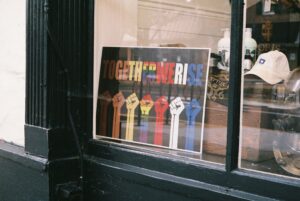If there is one thing we could count on in recent years it was that the price of eggs was going to go up. Since the economic struggles of the Covid lockdown the price of food has been a part of political discussion. Now, with the constant back and forth threats of tariffs on goods coming into the U.S from abroad, the price of many staple food items have soared. A 25% tariff on Mexican goods, where we get much of our tomatoes, avocados, berries, and citrus fruits. Another 25% tariff on Canada, who supplies the U.S with potatoes, grains, meat, and fish.
These rising prices have put a larger burden on the working and middle classes as they are priced out of the food they used to count on to feed their families. Food items, especially whole foods and produce are becoming a luxury fewer and fewer can afford. And, much like other luxuries, they are being touted as status symbols among those who can (or at least pretend to) afford it.
In the years after Covid-19, we have seen a boom in health-conscious content on social media. The rise of the wellness influencer has coincided with the rise of Erehwon Market. The L.A. based bougie health food store is packed with pristine shelves stocked with aesthetically packaged goods. Popularized by celebrities, it is the place influencers go to vlog their grocery shopping trips and film their ludicrously expensive hauls. These are made even more outrageous by an additional $17 strawberry smoothie. Erewhon isn’t a new store – in fact, it’s almost 60 years old. So why is it making waves now?
The myth of Erehwon
Erewhon was founded in 1966 by a Japanese couple that subscribed to a belief system called the Unique Principle. They were tasked with spreading this ideology that taught the best way to ensure world peace was a diet of whole grains and vegetables. Erewhon started as a small store that carried organic products. Employees went to great lengths to ensure that promises made on the labels of these products were true. It was a store frequented by hippies until Tony Antoci bought it in 2011.
Under the Antoci family direction, Erewhon was transformed into a trendy, aesthetically pleasing health food store. A perfect setting for influencer content, which there is plenty of. Erewhon and the food it sells have become a status symbol in many ways, and with that, comes social media clout. Right now, TikTok is flooded with videos of influencers sharing their smoothie orders or trying the infamous strawberry smoothie. A trip to Erewhon isn’t just a grocery run. It’s a luxury experience that people can’t help but rub in their followers’ faces. It’s an extremely manufactured environment and that’s it’s appeal.
“People may want “natural food,” but nature itself is the inconsistent chaos from which they and their food have been delivered. They do not want nature but its opposite: civilization, control, an experience designed down to the inch.”
– Kerry Howley for The Cut
You go to Erewhon and you get your produce and your snacks. Everything is labeled with hippie-like buzzwords that make you feel like you’re close to nature. But you’re not. You’re in a grocery store, where food is flown in from oceans away after being grown and harvested by people you will never meet. Just like any other grocery store.
Food movements have lost their way
With high price tags that are only feasible for the wealthy, comes an idea that a healthy diet and lifestyle are only available to the rich. In reality, these people are paying exorbitant prices for the brand name Erewhon and all the buzzwords that go along with it. Erewhon has become a symbol of everything wrong with the healthy and sustainable food movement. It’s elitist and shows blatant disregard for those that need it the most.
Movements around food and agricultural sustainability have become elitist. Losing sight of the actual issues at hand.
“sometimes seem to care more about the taste of some Napa wine than about the migrant workers who harvested those grapes.”
– Eric Schlosser, author of Fast Food Nation
The blatant disregard we see here feels similar to that we see when celebrities do photoshoots with fresh produce and stock their fridge with more food than they can use before it rots.
American food deserts
Food deserts are an area in which people have little access to healthy food. People living in a food desert often don’t have proper grocery stores nearby. These areas tend to affect low-income populations and people of color the most. They can be found in both rural and urban areas, though the majority of them are found in the West, Midwest, and the South. 6.1% of the population live in food deserts. This comes with significant health risks because the most accessible food in these areas are highly processed. Food deserts are linked to higher rates of obesity, cardiovascular disease, cancer, high blood pressure, and type two diabetes.
It’s becoming more of an issue in America that healthy food is becoming less accessible. Wealthy citizens that are able to afford healthy food along with various other beneficial activities like gym memberships, exercise classes, or even just the time to attend these events, pass judgements on those who can’t. Sure, you can buy a 2lb bag of carrots for just over $2.00 or you could buy three boxes of shells and cheese for just $0.30. One of which is a meal that adds up to nine servings, allowing you to feed a family of four for at least two meals. The other is healthier but has too few calories to serve as a single meal. So, what is the most cost effective solution? These are the kinds of problems more and more people are facing as the economic tides turn for the worst.
We’ve got scurvy
While less healthy, processed foods are often more accessible to lower income Americans, this has lead to a sharp increase in vitamin deficiency-induced diseases. One of the most popular? Scurvy.
Thought of as an old-timey pirate disease, yet it is making quite the comeback. As of July 2024, scurvy cases in children have tripled in five years. Scurvy is caused by a deficiency in vitamin C commonly found in fruits. This means that American kids are not getting enough nutrients to thrive. Left untreated scurvy can cause anemia, loss of teeth, and failure to heal wounds. This is incredibly concerning, as it can have long-lasting consequences and be detrimental to the health of these children long term.
The haves and have-nots
Healthy eating has become a luxury in the U.S. With just as many social media posts flashing grocery store hauls as Louis Vuitton bags, it’s evident that we are in a society in which health is bought. It’s a product that is packaged and sold for sky high prices in stores like Erewhon. It’s advertised on TikTok and Instagram and used in photoshoots as a prop. The constant threat of higher prices on produce and basic necessities makes us believe health is kept for those who can buy it and the growing majority must suffer the consequences.
The fact that food deserts exist in the first place shows the root of the issue that these movements around accessible and healthy food face. It’s a lack of empathy for other people, especially low-income communities and people of color. This extends past food insecurity to those that grow, harvest, and transport their food. It extends to the impact the food production system has on the environment. It all adds up to an increasing population of Americans suffering with the short end of the stick.
Check out:













Be First to Comment